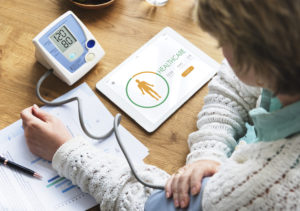
When you visit your physician’s office, do they check your blood pressure in both arms? If not, they should be doing it, especially if you’re over the age of fifty, have diabetes, or smoke. Research shows that blood pressure values that differ significantly between the two arms may be a sign of underlying peripheral vascular disease.
What is peripheral vascular disease? It’s a condition where blood vessels called arteries become too narrow. Arteries are the vessels that carry blood from your heart to all the tissues in your body. These sturdy pipelines serve as a “lifeline” to all the organs and tissues in your body. They also supply your extremities, including your arms and legs with oxygenated blood. They are quite efficient at doing this job as long as your heart and arteries are healthy.
One of the first places you typically see peripheral vascular disease is in the arms and legs, most commonly the legs. How do you know if you have it? People with significant peripheral artery disease often experience pain, numbness, tingling, or cramping in a leg, or both legs if both are affected, if they walk a certain distance. As the narrowing of the arteries worsens, the leg discomfort comes on with shorter and shorter walking distances. If you have peripheral artery disease, you may also experience leg cramps when you walk. Typically, the leg discomfort goes away upon resting. However, leg cramps can have other causes as well.
The Role that Blood Pressure Readings Play in Peripheral Vascular Disease
Sometimes, peripheral artery disease can be silent, at least in the early stages. If you don’t routinely walk significant distances, you might not know you have it since exercise is what brings it on in the early stages. This happens because exercise increases the demand for oxygenated blood and narrowed arteries cannot meet the demands as easily. However, taking blood pressure readings in both arms could alert you and your doctor to possible early peripheral vascular disease even when you don’t have obvious symptoms.
A 2012 study highlights how important knowing the blood pressure in each arm is. What the study showed was that systolic blood pressure readings that differ more than 10 points between the two arms should raise the suspicion of possible peripheral vascular disease. Systolic blood pressure is the top number of blood pressure readings. It represents the force in the wall of arteries when the heart is pumping. The lower number is the pressure within the arterial wall when the heart is relaxing between heartbeats.
If systolic blood pressure differs by more than 10 points between the two arms, your physician could recommend a further work-up to look for peripheral vascular disease. Whether they recommend a workup will depend on whether you’re at high risk and whether you have other signs suggestive of arterial disease on physical exam.
The difference in blood pressure between the two arms is a possible sign of peripheral vascular disease of the arteries that supply the arms with blood and oxygen. But people who have arterial disease in the arms often have it in their legs too. If you’re over the age of 50, smoke, have a strong family history of heart or blood vessel disease, or have diabetes, your risk of developing peripheral vascular disease is higher. According to Harvard Health, peripheral vascular disease affects more Americans than cardiovascular disease and stroke combined.
Take Your Blood Pressure Properly and Check It at Home Too
These days, it’s easy to check your blood pressure using home equipment. If you check your blood pressure at home, make sure you’re using the proper size cuff, your bladder is empty, and you’ve rested in a chair for at least 5 minutes beforehand. Activity, a full bladder, and the wrong cuff size can all impact the blood pressure reading you get. Don’t consume caffeine or nicotine before checking your blood pressure. Make sure you’re sitting with your back supported and feet on the floor. Your elbow should be resting on the arm of a chair or table at the level of your heart. Also, take a few readings in each arm. It’s not uncommon for the first reading or two to be higher than subsequent measurements. Record the values so you can show your physician.
Other Risks of Having a Wide Variation in Blood Pressure Between Arms
Are there other possible risks of having a wide variation in blood pressure readings between arms? According to a study published in the Lancet, having a 10 point or more difference in systolic blood pressure between the two arms is also associated with a higher risk of dying of stroke and cardiovascular disease. So, simple tests like measuring blood pressure in both arms can tell us a lot about future health risk! If your medical providers don’t normally check blood pressure in both arms, ask them to do it! Then, check your own readings at home too. Take a proactive role in your own health care by investing in the equipment you need to get an accurate blood pressure reading. Then, learn how to use it properly.
Keeping tabs on your blood pressure is one of the most important things you can do for your health. Hypertension, in general, is a leading risk factor for cardiovascular disease and stroke, and it’s something that can be easily treated through lifestyle or medications. Know your pressures and keep track of them in both arms!
Conclusion
It’s something health care doesn’t do often enough, but now that you’re aware, you can make sure you know what your own pressures are on each side. Take advantage of this way to monitor your health.
References:
Family Practice News. February 1, 2012. “BP Differences between Arms May Signal Vascular Disease”
Harvard Health Publishing. “Different blood pressure in right and left arms could signal trouble”
The Lancet. Volume 379, Issue 9819, P905-914, March 10, 2012.
Merck Manual. Eighteen edition. 2012.
